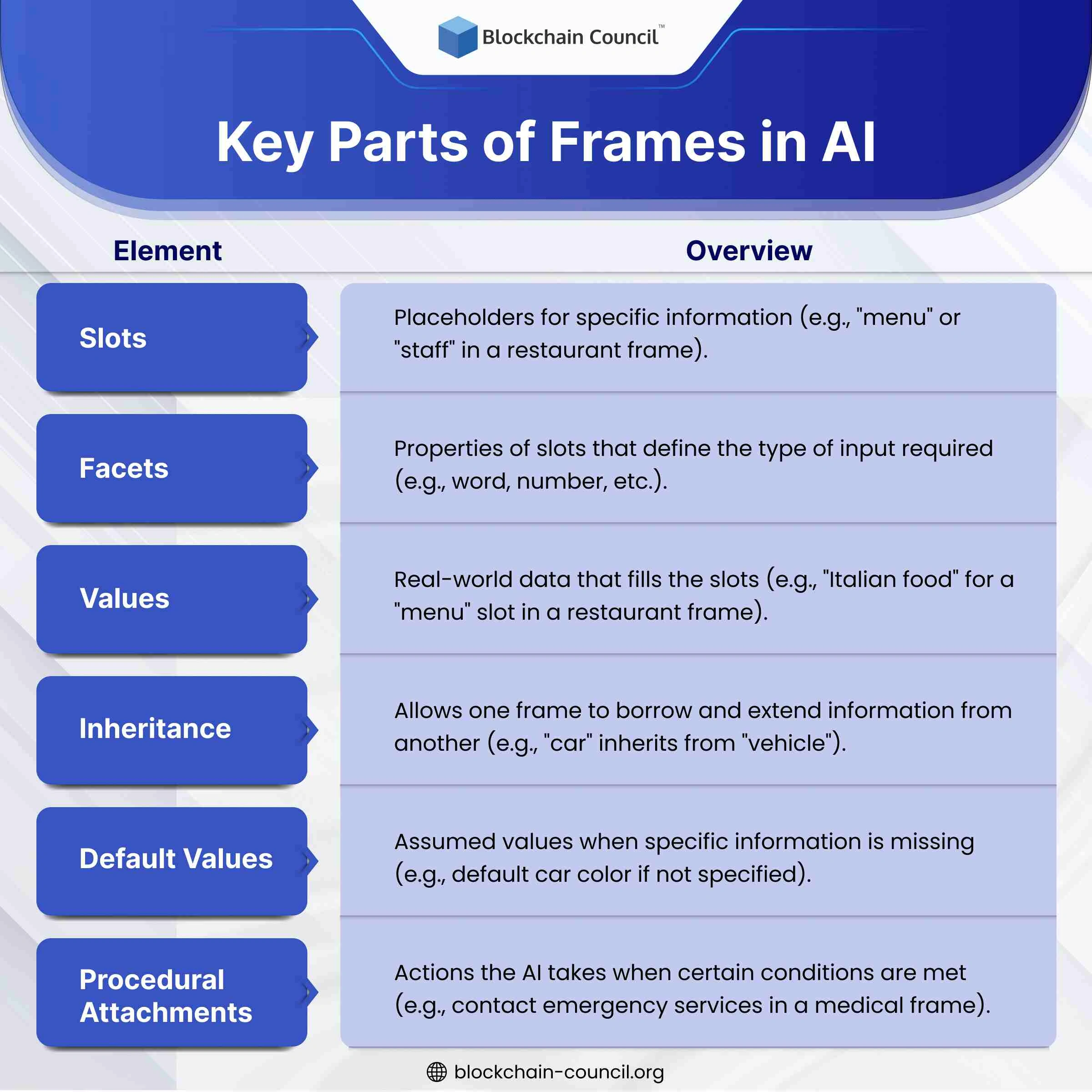
- Blockchain Council
- January 16, 2025
Artificial intelligence (AI) has introduced many ideas that enable machines to interpret the world around them. One of these concepts is “frames.”
What Exactly Are Frames in AI?
Frames in AI are essentially data structures that depict typical situations. This idea was first introduced by Marvin Minsky during the 1970s to help AI systems store knowledge about familiar events. You can compare frames to templates or outlines, which allow an AI system to grasp a situation by offering it a structured format for understanding expected elements.
These templates include slots that hold details about a specific object or scenario. They also give directions on what the AI system should do when faced with a particular situation. Each frame corresponds to a concept or event and comes with spaces for the expected parts. When AI encounters new information that fits into a frame, it “fills in” the missing details, allowing it to make sense of the data and decide on the next steps.
The core idea of frames is to establish a system where AI can access, understand, and use information in a way similar to how humans think. This helps AI systems handle complicated situations more effectively. For instance, if you are developing an AI model to interpret a “birthday party,” you would create a frame that includes components like guests, food, and gifts. The AI system could then use this frame to make sense of any new details about birthday parties it encounters.
Looking to deepen your AI expertise? The Master Artificial Intelligence (AI) Learning Path could be the step that takes your career to the next level!
How Do Frames Function in AI?
As discussed, frames consist of different placeholders or slots for the various aspects of a situation. Each slot is assigned a value, which can either stay fixed or change according to the context. Let’s return to the “birthday party” example:
- Event: Birthday party
- Guests: John, Mary, Alice
- Food: Cake, snacks
- Location: Home, park
- Time: Afternoon
When the AI detects a birthday party, it checks its frame and looks for the expected elements. If it finds them, it completes the slots with specific details, like “John” or “park.” If it encounters new aspects (for instance, “balloons”) that weren’t previously in the frame, it adds these as extra data. This process allows AI systems to swiftly understand and process new information by comparing it to what they already know.
Key Parts of Frames in AI
A typical frame is made up of several important elements:
- Slots: These are placeholders for specific pieces of the frame. In a “restaurant” frame, slots might cover details such as menu, staff, or seating.
- Facets: Facets are extra properties of slots, like determining whether the value in a slot should be a word, number, or something else. For example, a location slot may require a city, while the seating slot might expect a number.
- Values: These populate the slots when AI interacts with real-world data. In the restaurant example, a “menu” slot could be filled with “Italian food” when the AI is dealing with an Italian eatery.
- Inheritance: This function enables one frame to borrow information from another. For instance, a “car” frame can inherit data from a “vehicle” frame but include its specific details, such as “number of doors” or “engine type.” This method makes managing information simpler and avoids unnecessary repetition.
- Default Values: These are assumptions the system makes when certain information is missing. For example, if an AI knows it’s working with a “car” frame but doesn’t know the car’s color, it might assume a default color based on its past knowledge.
- Procedural Attachments: These tell the AI what actions to take when specific conditions are met. For example, if a “medical emergency” frame is activated, the AI might automatically contact emergency services.
Why Are Frames Crucial?
Frames simplify how AI handles new data. Instead of analyzing each situation from scratch, AI can rely on frames to interpret familiar scenarios it has already seen. This efficiency is especially valuable when the AI system is performing tasks like understanding language or making decisions.
For example, in natural language processing (NLP), frames help AI make sense of the context behind a sentence. If someone asks, “Where’s the best pizza place nearby?” the AI doesn’t have to decode every individual word. It can use a “restaurant query” frame, which includes details like food type, location, and user preferences, allowing it to provide a quick answer.
Examples of Frames in Real AI Applications
Frames are employed in a wide range of AI applications, from virtual assistants to visual recognition systems. Below are some key examples:
Natural Language Processing (NLP)
Frames assist in understanding sentences based on their context. For instance, a frame might help AI identify that in the sentence “John purchased a book at the store,” John is the buyer, the book is the object, and the store is the location. This structured approach helps AI respond accurately.
Robotics
Frames can help robots interpret and navigate their surroundings. In a warehouse, a robot might use a frame to determine what counts as an obstacle and what represents a clear path, enabling it to make decisions on movement.
Computer Vision
Frames are used to identify objects. When an AI system views a car, it uses frames to recognize different parts (like wheels or windows) and understands that it is looking at a vehicle.
Virtual Assistants
Virtual helpers like Siri and Alexa use frames to handle various user requests. For example, if asked about the weather, the assistant will use a “weather request” frame, with slots for location and date, to fetch relevant data.
Medical Diagnosis
In healthcare, AI can use frames to assist in diagnosing illnesses. A “flu diagnosis” frame might include symptoms like fever or sore throat. When a patient presents these, the AI can use the frame to suggest a diagnosis.
Challenges of Using Frames
Despite their usefulness, frames have certain limitations. One major challenge is that they can become overly rigid or too simplistic when handling highly variable or complex information. Additionally, if frames are not designed with enough adaptability, they might struggle with unexpected or unfamiliar details. Another issue is that frames alone may not capture the deeper relationships between elements, something more advanced models can do better.
Comparing Frames with Other Models
Frames are just one way to represent knowledge in AI. Other approaches include logic-based models or semantic networks. Frames have the benefit of flexibility and the ability to manage real-world situations. While logic-based systems focus on strict rules, frames are more adaptable, which is useful in environments where all variables might not be fully known.
Conclusion
To conclude, frames in AI are data structures that help machines organize and process knowledge about objects or situations. They offer context, allowing AI systems to interpret information in a structured, flexible way. However, they have their limitations, and in certain situations, more complex models may be needed for handling challenging information.






































































 Guides
Guides News
News Blockchain
Blockchain Cryptocurrency
& Digital Assets
Cryptocurrency
& Digital Assets Web3
Web3 Metaverse & NFTs
Metaverse & NFTs
